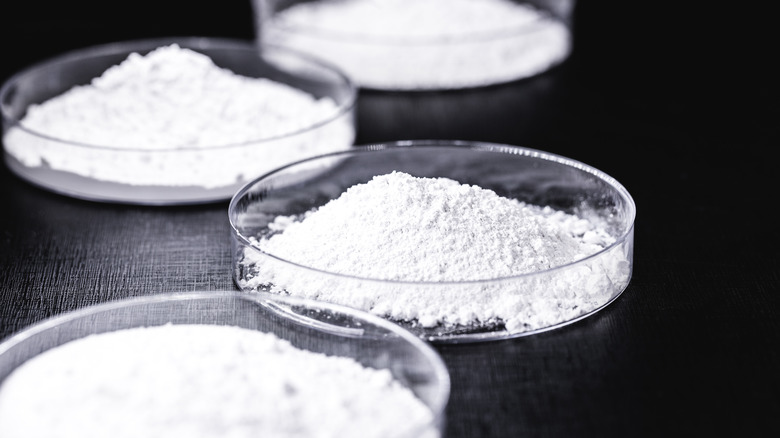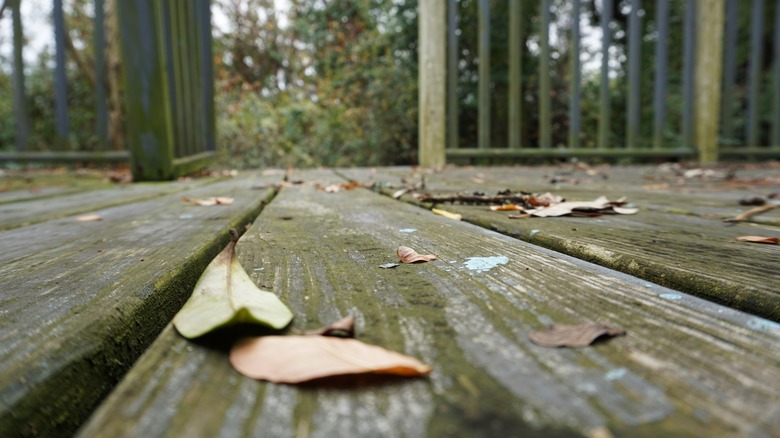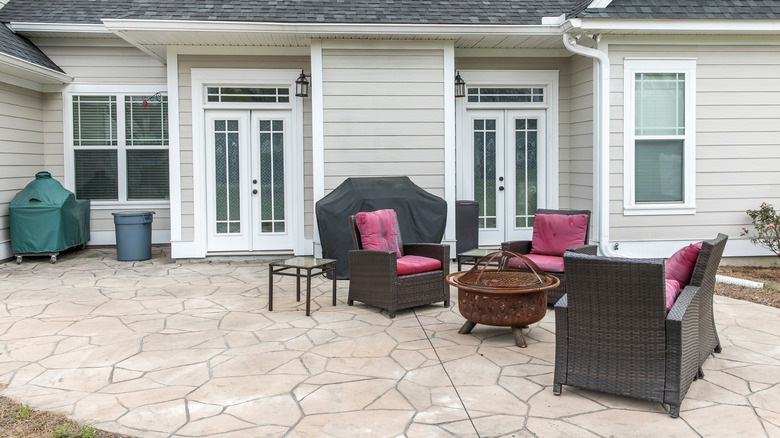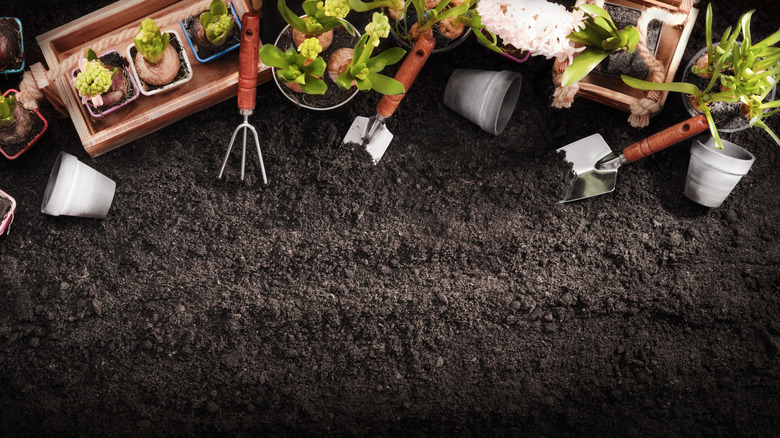A strong degreaser makes removing greasy, sticky buildup off your kitchen walls, appliances, or grill a breeze. As Jagran Josh explains, sodium carbonate — also known as washing soda, soda ash, or soda crystals — is a powerful cleaner used for ages but has gone chiefly unnoticed these days.
Although washing soda is commonly found in the grocery store’s laundry aisle, it’s also utilized in various DIY cleaners. If you can’t find it in stores, you can always get it online, or you can create your own washing soda at home with baking soda and your oven (it’s a lot easier than you think!). Washing soda is widely used in home cleaning, from washing kitchen equipment to removing outdoor furniture stains. The best thing about using washing soda is that it is a low-cost, environmentally friendly, and completely safe green cleaning product. But what is washing soda, and why is it so essential in the cleaning process?
What is washing soda?

Washing soda is a chemical compound that can be used to remove stubborn stains from clothes and almost anything else. It is also a key ingredient in most DIY laundry detergent formulations, according to Martha Stewart. Washing soda is also commonly used to treat hard water in commercial detergents as its sodium carbonate compound “softens” water, allowing other cleaning agents to lift filth off of clothes and suspend it in the wash water. In addition, the washing soda binds to the minerals that cause hard water, allowing the detergent to be effectively absorbed into the fibers for cleaner garments. Although the two substances are closely related, you should not mistake the washing soda formula for baking soda.
Washing soda can be utilized as a turbo-charged baking soda in many types of home uses. To utilize it, dissolve 1 cup of sodium carbonate in 2 quarts of water. Sponge away messes to see how quickly grease vanishes. While this powder is relatively safe, it is also extremely strong, so ensure you wear rubber gloves to protect your hands and avoid contact with your eyes.
Laundry cleaning
A 1/2 cup of washing soda crystals is recommended to be added to a load of laundry to brighten it up and prevent clothes from looking “faded.” Because washing soda is alkaline, it works exceptionally well on whites, brightening and cleaning whites. That’s why the primary ingredient in any homemade laundry detergent is washing soda.
Should you make your own detergent out of washing soda? For starters, it’s a lot less expensive than the store-bought version. Furthermore, store-bought detergents commonly contain silicones, sulfates, dioxides, and other dangerous chemicals to children, particularly toddlers. Making a homemade detergent with a bit of washing soda, Borax, and a bar of soap may take a little additional time out of your day, but it’s well worth it, Wellness Mama explains. To use it as a stain remover, soak cotton or linens in a solution of warm water and washing soda to help dissolve them. This method can remove grease, blood, ink, tea, coffee, and other stains.
Cleaning shower curtains
Ira Shpiller/Shutterstock
When you wash grease stains or soapy residue using regular detergent, the grease may spread or not even clear away. So, before washing shower curtains or any other similar items with regular detergent, sprinkle an even layer of washing powder on the grease spots.
Make a powerful washing soda solution by dissolving 1 cup of washing soda in 1 gallon of boiling water. Scrub your vinyl shower curtain and liner with the solution and a sponge. The washing soda solution will aid in the removal of soap scum, mildew, and foul odors. You can also clean your vinyl shower curtain liner in the washing machine. Simply toss it in it with a couple of clean bath towels and a 1/2 cup of washing soda, and after a gentle cycle, hang the curtains to dry. Arm & Hammer mentions that you can use washing soda crystals and powder to clean other bathroom-related items, such as toilet bowls, tiles, sinks, and tubs. Dissolve a 1/2 cup of washing soda in 1 gallon of warm water to clean huge areas, scrub the surface well and thoroughly rinse it.
Cleaning pots and pans
FabrikaSimf/Shutterstock
When it comes to cuisine, most of us enjoy delectable deep-fried dishes. However, these foods create greasy stains on cookware that are difficult to remove. Instead of forcefully scrubbing it, simply sprinkle a coating of washing soda on it. Apply a small amount of water until a thick paste forms. Let the paste sit for 20 minutes, then rinse the pan with warm water.
When you know exactly what’s in a product, it’s a lot easier to use it. Despite the fact that most dishwashing detergents are excellent, they occasionally leave a residue. To minimize residue and save money, you can use a store-bought washing soda detergent or make one yourself. Washing soda and a few drops of essential oil — be it grapefruit or eucalyptus oil — are all the ingredients you need for a powerful dishwasher detergent that will leave your pots and pans clean as a whistle, Mommypotamus wrote.
Oven and grill cleaning
Africa Studio/Shutterstock
Keeping with the delicious food theme, the oven is often the heart of the kitchen. But, whether it’s for something sweet or salty, or just a midnight snack, it seems to always be overworked and underserved when it comes to cleaning. So, it’s time to get down and dirty. Remove the oven racks and coat them with a washing soda and water paste in a 1:1 ratio. Apply the mixture on the oven glass as well. Scrub tough spots and rinse with water.
The same goes for your grill: Regardless of the season, many of us prefer grilled meals. However, after using the grill for a while, it may look as if it was rescued from a junkyard — not to mention the dangers that grease buildup poses to our health, as Demotix explained. Fortunately, it’s simple to clean and restore its original appearance with washing soda. The whole process involves removing the grill grates and soaking them in the 1:1 solution of warm water and washing soda. Allow the mixture to soak for a few minutes before scrubbing it. Your grill grates will be spotless in no time.
Clean deck and outdoor furniture

WKanadpon/Shutterstock
If your once-clean deck is now a tripping hazard because of the moss and other fungal growths that have accumulated, it’s time to restore it to its former glory. Cleaning it is so simple that you’ll wonder why you didn’t think of it sooner. All you need to do is mix 3 cups of washing soda with 1 cup of Borax and hot water in a bucket. Then, scrub away the pesky moss and algae with this mixture. Finally, wait a few moments before washing the deck with clean water — the alkalinity of the washing soda will easily remove all of the moss and mildew, as explained by Colin Seymour.
The same mixture — minus Borax — is the kryptonite you can use to clean your outdoor furniture. Plastic deck furniture is especially susceptible to a wide range of weather conditions and is easily damaged, making it more challenging to maintain than other furniture forms. Simply combine a higher concentration of washing soda and water in a strong solution and give your furniture pieces a thorough cleaning.
Freshening patios and paths

Ursula Page/Shutterstock
Mildew and rotting leaves are common on patios and walkways. However, these compounds not only make the paths slick to walk on, but they also make them look unappealing. To clean your patios and paths on your property nicely, sprinkle some washing soda on top of the rotting leaves and allow it to sit overnight, advised Dominic Jones Jewelry. Then, for optimal results, wash it off the next day with lukewarm water.
Scrub the patio or path down with a mixture of extra washing soda and hot water if you notice any slime left by decaying leaves. This removes the filth that has accumulated thoroughly. However, beware: If you spray the plants during this procedure, you’ll wind up with a deserted grassland in place of your lovely garden the next day. Because the alkalinity of the washing soda harms and wilts the plants, use caution when applying the solution.
Cleaning garden tools and silverware

Pasko Maksim/Shutterstock
Your lawn tools grow exceedingly dusty after extensive use in keeping your landscape spotless. It’s also critical to keep these garden tools in good working order to keep their sharpness, the unclean instruments don’t transmit plant diseases, and you can use them for as long as possible.
The first step in proper maintenance is to clean the equipment thoroughly to avoid rust. Cleaning your garden tools with washing soda is an excellent idea, especially since it’s a green solution that doesn’t damage them. All you have to do now is scrub the instruments with sodium carbonate, ideally with a stiff bristle brush. Next, hose down the tools and dry them in the sun to maintain their sharpness and prevent rust.
If you don’t know yet, silverware and silver jewelry can also benefit from washing soda. Wonder How To recommended soaking your silver in an ordinary washing soda solution for around 15 minutes: The tarnish will vanish before your very eyes! Then, rinse the items well after soaking and polish with a clean microfiber cloth.


